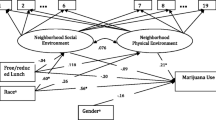Abstract
Social and environmental influences on gambling behavior are important to understand because localities can control the sanction and location of gambling opportunities. This study explores whether neighborhood disadvantage is associated with gambling among predominantly low-income, urban young adults and to explore if we can find differences in physical vs. compositional aspects of the neighborhood. Data are from a sample of 596 young adults interviewed when they were 21–22 years, who have been participating in a longitudinal study since entering first grade in nine public US Mid-Atlantic inner-city schools (88 % African Americans). Data were analyzed via factor analysis and logistic regression models. One third of the sample (n = 187) were past-year gamblers, 42 % of them gambled more than once a week, and 31 % had gambling-related problems. Those living in moderate and high disadvantaged neighborhoods were significantly more likely to be past-year gamblers than those living in low disadvantaged neighborhoods. Those living in high disadvantaged neighborhoods were ten times more likely than those living in low disadvantaged neighborhoods to have gambling problems. Factor analysis yielded a 2-factor model, an “inhabitant disadvantage factor” and a “surroundings disadvantage factor.” Nearly 60 % of the sample lived in neighborhoods with high inhabitants disadvantage (n = 375) or high surroundings disadvantage (n = 356). High inhabitants disadvantage was associated with past-year frequent gambling (odds ratios (aOR) = 2.26 (1.01, 5.02)) and gambling problems (aOR = 2.81 (1.18, 6.69)). Higher neighborhood disadvantage, particularly aspects of the neighborhood concerning the inhabitants, was associated with gambling frequency and problems among young adult gamblers from an urban, low-income setting.

Similar content being viewed by others
References
Gilliland JA, Ross NA. Opportunities for video lottery terminal gambling in Montréal: an environmental analysis. Can J Public Health. 2005; 96: 55–59.
Wilson DH, Gilliland J, Ross NA, et al. Video lottery terminal access and gambling among high school students in Montréal. Can J Public Health. 2006; 97: 202–206.
Weiss MJ. The clustering of America. New York: Harper & Row; 1988.
Welte JW, Wieczorek WF, Barnes GM, et al. The relationship of ecological and geographic factors to gambling behavior and pathology. J Gambl Stud. 2004; 20: 405–423.
National Gambling Impact Study Commission. National gambling impact study commission final report. Washington, DC: National Gambling Impact Study Commission; 1999.
Barnes GM, Welte JW, Tidwell MCO, et al. Gambling on the lottery: sociodemographic correlates across the lifespan. J Gambl Stud. 2011; 27: 575–586.
Welte J, Wieczorek W, Barnes G, et al. Multiple risk factors for frequent and problem gambling: individual, social and ecological. J Appl Soc Psychol. 2006; 36: 1548–1568.
Brenner AB, Bauermeister JA, Zimmerman MA. Neighborhood variation in adolescent alcohol use: examination of socioecological and social disorganization theories. J Stud Alcohol Drugs. 2011; 72: 651–659.
Sampson RJ, Groves WB. Community structure and crime: testing social-disorganization theory. Am J Sociol. 1989; 94: 774–802.
Shaw C, McKay H. Juvenile delinquency and urban areas. 2nd ed. Chicago: University of Chicago Press; 1969.
Peacock RB, Day PA, Peacock TD. Adolescent gambling on a Great Lakes Indian Reservation. J Hum Behav Soc Environ. 1999; 2: 5–17.
Pearce J, Mason K, Hiscock R, et al. A national study of neighbourhood access to gambling opportunities and individual gambling behaviour. J Epidemiol Community Health. 2008; 62: 862–868.
Volberg RA. Gambling and problem gambling in Nevada. Carson City: Department of Human Resources; 2002.
Shinogle J, Norris DF, Park D, et al. Gambling prevalence in Maryland: a baseline analysis. Baltimore: Maryland Institute for Policy Analysis and Research; 2011.
Leventhal T, Brooks-Gunn J. Children and youth in neighborhood contexts. Curr Dir Psychol Sci. 2003; 12: 27–31.
Ialongo N, Poduska J, Werthamer L, et al. The distal impact of two first-grade preventive interventions on conduct problems and disorder in early adolescence. J Emot Behav Disord. 2001; 9: 146–161.
Lesieur HR, Blume SB. The South Oaks Gambling Screen (SOGS): a new instrument for the identification of pathological gamblers. Am J Psychiatry. 1987; 144: 1184–1188.
American Psychiatric Association. Diagnostic and statistical manual of mental disorders, revised third edition. Washington, DC: American Psychiatric Association; 1987.
Volberg RA, Nysse-Carris KL, Gerstein DR. 2006 California problem gambling prevalence survey. Chicago: National Opinion Research Center at the University of Chicago; 2006.
Elliot DS, Huizinga D, Ageton SS. Explaining delinquency and drug use. Beverly Hills: Sage; 1985.
Harrell SP. A multidimensional conceptualization of racism-related stress: implications for the well-being of people of color. Am J Orthopsychiatry. 2000; 70: 42–57.
Ensminger ME, Forrest CB, Riley AW, et al. The validity of measures of socioeconomic status of adolescents. J Adolesc Res. 2000; 15: 392–419.
Rogers WH. Regression standard errors in clustered samples. Stata Tech Bull. 1993; 13: 19–23.
Brook DW, Brook JS, Rubenstone E, et al. Developmental associations between externalizing behaviors, peer delinquency, drug use, perceived neighborhood crime, and violent behavior in urban communities. Aggress Behav. 2011; 37: 349–361.
Acknowledgments
This study was funded by a research grant from the National Institute of Child and Human Development, National Institutes of Health (NICHD-NIH, RO1HD060072—P.I. Dr. Martins). The Intervention Trial is funded by National Institute on Drug Abuse grant RO1 DA11796 (P.I. Dr. Ialongo). We thank Scott Hubbard for data management.
Author information
Authors and Affiliations
Corresponding author
Rights and permissions
About this article
Cite this article
Martins, S.S., Storr, C.L., Lee, G.P. et al. Environmental Influences Associated with Gambling in Young Adulthood. J Urban Health 90, 130–140 (2013). https://doi.org/10.1007/s11524-012-9751-1
Published:
Issue Date:
DOI: https://doi.org/10.1007/s11524-012-9751-1




